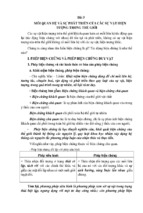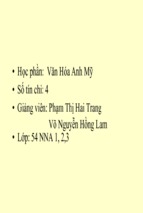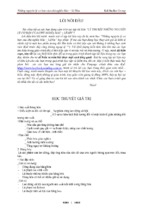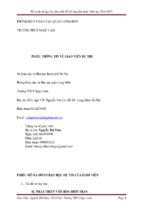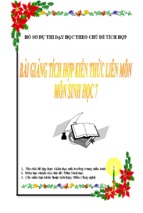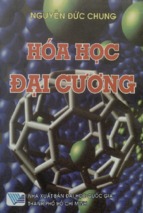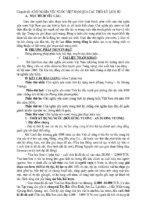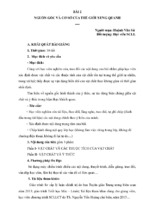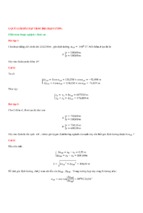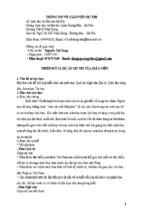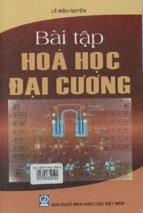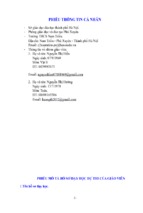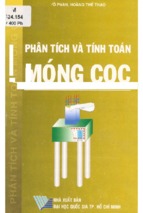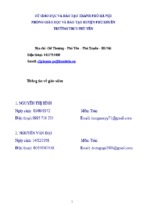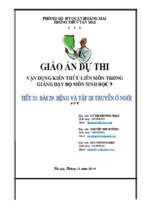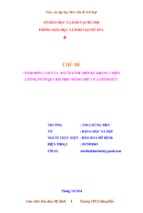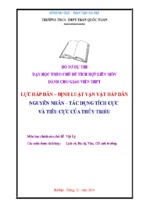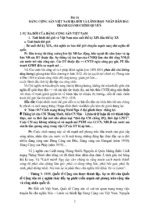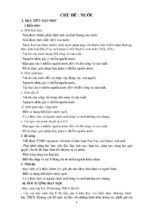Mô tả:
lesson plan unit 4 for a better community
Unit 4: For a better community
Language
A.Aims and Objectives:
By the end of the lesson, students will be able to:
- Use the adjectives ending with -ed, -ing, -ful and -less in context.
- Pronounce / nd/ , /ŋ/ and /nt/ in words and sentences correctly.
- Use irregular past tense verbs, the past simple and past continuous correctly in combination.
B. Preparations:
- Teacher: Handouts, textbook, pieces of papers, cassette, pictures, power point.
- Students: Textbook
C. Methods: - The whole lesson: Integrated, mainly communicative.
D. Procedures:
Time/Stages
Activities
1. Warm up
(5 minutes)
- T asks Ss to tell the whole class about their volunteer work.
- T listens and gives marks.
2. New lesson
(37 minutes)
A. Vocabulary:
Task 1:
- Ask Ss to read the conversation again and underline the adjectives
ending with - ed, -ing, -ful and -less
- T checks some Ss.
- Guide Ss to distinguish the use and meaning of these adjectives.
+ Adjectives ending with -ed: are often used to describe how people
feel about something
Ex: He was surprised to see Helen. She’d told him she was
going Australia.
+ Adjectives ending with -ing: are often used to describe things and
situations that cause the emotions.
Ex: Have you seen that film? It’s absolutely terrifying.
+ Adjectives ending with -ful: have most of the times positive
meanings but not always ( “awful” or “dreadful” have negative
meaning = “ frightening”)
Ex: My best friend is a rich, powerful lawyer.
+ Adjectives ending with -less: often have negative meaning but not
always ( “priceless” = “valuable”).
Ex: You must remember recharge your phone. Without its
batteries, it’s useless.
* Key:
- ed: disadvantaged, interested, excited
- ing: interesting
- ful: useful, helpful, meaningful
- less: hopeless
Task 2:
- Ask Ss to work individually in 3 minutes then have them compare
their answer with their partner.
- Check Ss' answers and give explanation if any.
Interactions
T <--> Ss
Individually
T <--> Ss
Pair work
Group work
Ss <--> Ss
1
- exchange the answers with their partners.
- provide the answers.
* Key:
1. meaningless 2. interested
3. hopeless
4. useful
5. excited, meaningful
6. exciting.
2. Pronunciation
Task 1:Identify the word having the sounds
- Play the recorder and let Ss listen and repeat.
- Have Ss work in pairs.
- Invite two or three Ss read again and then give comments
- Explain the requirement of this activity to Ss, focusing on the
importance of pronouncing the ending sounds correctly in English.
Task 2:
Listen and repeat
- Explain the requirements of this activity to students,
highlighting the importance of pronouncing the ending sounds
correctly in English, which is a difficulty for a lot of Vietnamese
students because they tend to omit the final sound when they
speak English (spend, spent, lend, lent)
- Play the recording and ask students to write /nd/, /ŋ/ , /nt/ above
the words that have the corresponding sounds.
- Then, put students in pairs to practice reading the sentences.
- Invite some students to read the sentences in front of the class.
Correct students’ mistakes if there are any.
Lead-in
Presentation
2. Grammar
Irregular past tense verbs
T asks Ss: What did you do yesterday?
Invites some Ss to answer the question and choose an answer which
has irregular past tense verb
Write the answer on the board, eg, I went to the cinema yesterday.
T points at the verb went and asks Ss
T: What’s this?
Ss: This is the verb went.
T:Is went an irregular past tense verb or a regular past tense verb?
Ss: irregular past tense verb.
T: very good.
T <--> Ss
Individually
T <--> Ss
individually
pair work
T says many verbs have irregular positive past simple forms. There
are no spelling rules for these forms, so you need to learn them by
heart.
Then the T show some irregular verbs.
Do -> did; build -> built; come -> came;
Find -> found; read -> read; see -> saw;
Tell -> told; take -> took; go -> went;
2
Win -> won; write -> wrote; be -> was/were
Practice
The T asks Ss to make a sentence with irregular verbs above
Then T checks and corrects.
Production
Activity 1
- Ask students to read the activity, check if they understand.
- Ask students to pay attention to the time expressions in brackets
and ask them to find the verb tense to go with these time
expressions.
- Students work on their own first to rewrite the sentences in the
past tense, using the time expression in brackets.
- Ask students to work in pairs to check their answers.
- Check students’ answers, highlighting the irregular past tense
verbs.
Keys activity 1
1. I wore jeans to school yesterday.
2. My sister and I bought a lot of clothes last summer.
3. My father read newspapers in bed last night.
4. My mother made my bed last Sunday.
5. I wrote letters to my grandparents yesterday afternoon.
Lead-in
The past simple vs. the past continuous with when and while
The T writes the sentence on the board: “While I was having
dinner, the phone rang”.
T points at the first clause and asks Ss: while + clause using the
past continuous.
T: This action lasted or happened suddenly?
S: lasted.
The second clause: clause using the past simple.
T: And the second action lasted or happened suddenly?
S: happened suddenly.
T: That’s right.
Presenting
T introduces the past simple and the past continuous using when
and while.
T says we often use the past continuous with the past simple. We
use the past continuous to talk about an action in progress, and
the past simple to talk about an action that interrupts it.
Practice
The T gives an action in progress: He was singing
And an action that interrupts: She came in his room.
T asks Ss to make a sentence using when or while.
Expected answer: While he was singing, she came in his room.
Or When she came in his room, he was singing.
3
T checks and corrects.
Production
Activity 2
- Have students do this activity individually. Observe and help
them if necessary.
- Ask students to match 1-5 with a-e and complete the sentences in
the past simple or the past continuous.
- Check students’ answers by asking individuals to take turns
reading the sentences aloud, then write them on the board.
- Elicit students’ answers about rules for combination of the
past simple and the past continuous, using when and while.
Keys activity 2
1.d We were walking in the park when it started to rain.
2.c While I was talking to a friend, the teacher asked me a question.
3.e We lost the keys while we were playing in the garden.
4.b We were sitting on a bench in the park when someone took our
school bags.
5.a When the telephone rang, I was having a bath.
3. Consolidation - Ask Ss to consolidate the main contents.
2 minutes
- Give feedback.
4. Homework - T asks Ss to do exercises again at home.
1 minute
- Prepare for the next lesson.
T <--> Ss
T <--> Ss
4
- Xem thêm -


